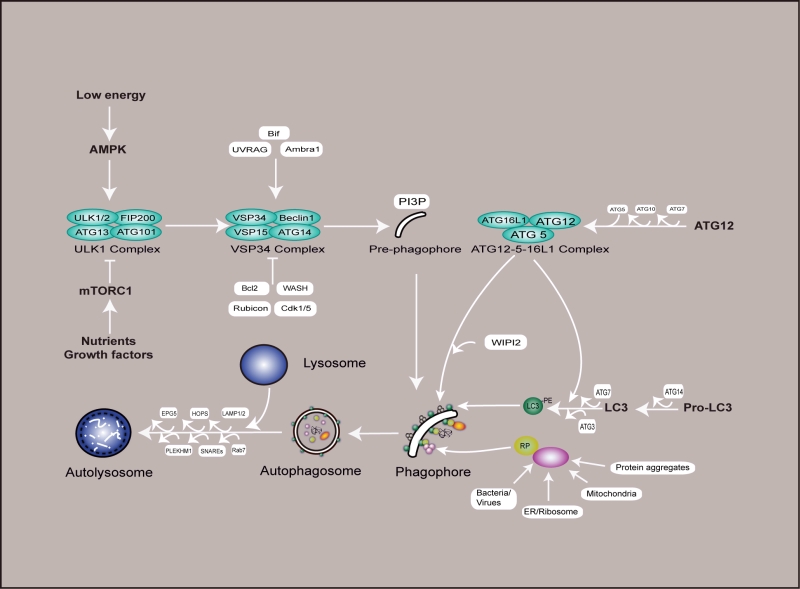Back to article: Recent progress in the role of autophagy in neurological diseases
FIGURE 1: Schematic of the mammalian autophagy pathway. This diagram shows a simplified version of autophagy. Nutrient or growth factor deprivation and low energy are well established autophagy inducers, leading to AMPK activation and mTORC1 inhibition, which positively trigger the formation of ULK1 complex (ULK1, ULK2, ATG13, FIP200 and ATG101). This complex subsequently activates the VSP34 complex (VSP34, Beclin1, VSP15 and ATG14) to promote PI3P synthesis in pre-autophagosomal structures, thus the initiation of autophagy has been activated. PI3P specifically binds its effector WIPI2 and catalyzes two types of ubiquitination-like reactions that are in charge of the extension and closure of the autophagosome double membranes. In the first reaction, ATG12 and ATG5 are conjugated to each other in the presence of ATG7 and ATG10, and ATG16L subsequently binds to them to form the ATG12–ATG5–ATG16L1 complex. In the second reaction, LC3-I and PE are conjugated to membranes in the presence of ATG14, ATG7 and ATG3, this process is facilitated by the ATG12–ATG5–ATG16L1 complex, ultimately leading to the formation of the complete autophagosome. Receptor proteins such as p62, NDP52, and NBR1 are responsible for the recognition of cytoplasmic targets (e.g., protein aggregates, damaged mitochondria, ER/ribosome, and infectious agents), and establish a bridge between LC3-II and specific ubiquitinated cargos to sustain the engulfment of a variety of substrates. In the final step of the process, the completed autophagosomes are then trafficked to fuse with lysosomes, resulting in the degradation of the vesicle contents, and this process is regulated by LAMP1/2, EPG5, HOPS, PLEKHM1 and SNAREs. AMPK – AMP-activated protein kinase; mTORC1 – mechanistic target of rapamycin complex 1; ULK1 – Unc-51-like kinase; ATG – autophagy protein; VPS34 – phosphatidylinositol 3-kinase VPS34; PI3P – phosphatidylinositol 3-phosphate; PE – phosphatidylethanolamine; RP – receptor protein.

